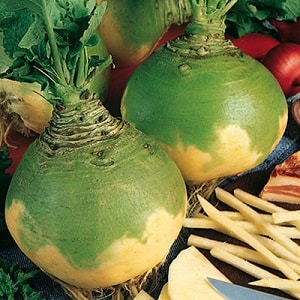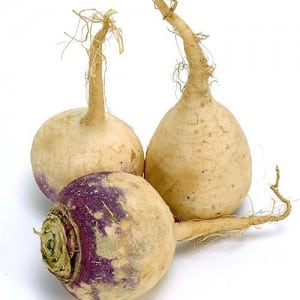Useful properties and contraindications of rutabaga: how to use the root vegetable in cooking, cosmetology and folk medicine
The plant we will talk about today is the closest relative of the turnip. They are often confused, but rutabaga is a completely different vegetable.
The vitamins and microelements included in its composition are simply irreplaceable. Those who want to maintain normal weight appreciate it for its low calorie content and ability to quickly and for a long time satiate. The root vegetable has a positive effect on almost all systems and internal organs. Let's get to know him better.
What kind of vegetable is this
Swede - a representative of the cruciferous family. It is tolerant of unfavorable conditions such as drought or light frost. At the same time, it does not lose its beneficial properties, and the vegetable has many of them. Next, we will consider the beneficial properties and contraindications for consuming rutabaga, but first we will study its composition.
This is interesting! Goethe greatly appreciated rutabaga dishes. And in one of the Swiss cities of Richterswil, once a year they organize a festival in honor of the vegetable. Our compatriots from the city of Ivanovo also borrowed the tradition.
About the chemical composition and nutritional value
The beneficial substances contained in the vegetable are shown in the table.
| Vitamins | Macronutrients | Microelements |
| Groups B | Phosphorus | Iron |
| Tocopherol (E) | Magnesium | Selenium |
| Biotin (N) | Calcium | Zinc |
| Ascorbic acid (C) | Potassium | Manganese |
| RR | Sodium | Copper |
| Niacin | Sulfur | |
| Phylloquinone (K) | Phosphorus |
In addition to the vitamins, macro- and microelements listed in the table, rutabaga contains fatty acids, sugars, starch, polyunsaturated fatty acids, represented by omega-6 and omega-3. The calorie content of the vegetable is 37 kcal per 100 g of product.
Why is it useful?
What are the health benefits and harms of vegetables?
Rutabaga helps eliminate swelling, relieve various inflammations in the body, remove phlegm accumulated in the lungs, and get rid of parasites and germs. Its regular use normalizes blood pressure and improves digestion.
If you eat the vegetable regularly, your bones and teeth become much stronger, as does your immune system. Rutabaga accelerates metabolic processes, removes toxins, has a beneficial effect on the walls of blood vessels, gets rid of cholesterol plaques, and starts regenerative processes.
Do no harm
Despite its positive properties, in some cases rutabaga can harm the body:
- with excessive consumption of vegetables, increased gas formation is observed;
- in the presence of acute or chronic diseases accompanied by an inflammatory process in the gastrointestinal tract, fiber irritates the mucous membrane of the internal organs of the digestive system and worsens the patient’s condition;
- substances that can cause harm are concentrated at the tip of the vegetable, so if you eat it with reduced immunity, intoxication may occur;
- the condition may worsen due to inflammation of the bladder;
- the likelihood of an allergic reaction;
- You should also remember about individual intolerance to the product.
It will help the body
The vegetable is useful both for the whole body and for its individual systems and organs: blood vessels, bones, gastrointestinal tract, immune system, for heart disease and high blood pressure, for strengthening the nervous system.
In addition, rutabaga helps in the fight against migraines, stroke, high cholesterol, and baldness. The vegetable cleanses and strengthens the walls of blood vessels, heals burns and wounds. It acts as a preventative against anemia. Regular consumption of the root vegetable improves the condition of the skin and hair, relieves fatigue and stress.
Did you know? In terms of vitamin C content, rutabaga is the leader among root vegetables. The young vegetable is especially rich in vitamins - 70 mg per 100 g of product.
For ladies in position
Let's figure out whether rutabaga is good for pregnant women.
During pregnancy, most women face problems such as swelling. Rutabaga helps get rid of them. In addition, the vegetable is rich in folic acid, which is necessary during pregnancy.
Another useful property of rutabaga is to keep hemoglobin normal or raise it to the required level. The vegetable provides the expectant mother and baby with vitamins and microelements.
Attention! Pregnant women should take special care of themselves and their diet. Therefore, even such a useful product as rutabaga is best introduced into the diet after consultation with a doctor.
Will keep your figure
Can rutabaga be used in diet food for weight loss? Definitely yes. IN It contains a lot of fiber, it perfectly cleanses the intestines and keeps you feeling full for a long time. The vegetable improves metabolism, which is also important when losing weight.
However, you should not replace all products with root vegetables; it is better to add it to different dishes. The raw fruit brings maximum benefits, but even after heat treatment it retains many useful substances. Another advantage is its low calorie content: a medium-sized vegetable will cost about 100-140 kcal.
How and for what diseases is it useful?
The high content of vitamins and microelements makes rutabaga indispensable for maintaining health and treating diseases. Now let's figure out why and how it is used.
For eczema
Rutabaga is one of the foods recommended for eating for eczema. If the patient does not have individual intolerance, the vegetable will be an excellent addition to the menu. For eczema, it is important that foods saturate the body with B vitamins and help maintain normal hemoglobin. Rutabaga easily copes with these tasks.
There's no need to give up at all
The vegetable has a beneficial effect on the entire body, but it is contraindicated in large quantities for people with high glucose levels.. Rutabaga has a high glycemic index, so it can be harmful.
For type 2 diabetes, it is better to add the root vegetable little by little to different dishes, combine it with protein products, and season it with vegetable oils. The vegetable crop is perfect as a preventative against diabetes. By consuming it regularly, a healthy person has less risk of contracting it.
Protects against cancer
Doctors note a significant reduction in the risk of cancer and improvement in the condition of patients who consume rutabaga regularly. The product is especially useful for men. The root vegetable reduces the risk of prostate cancer by half.
It is enough to consume the vegetable three times a week, it can be included in other dishes, for prevention and for oncology. It is advisable not to subject it to heat treatment.
What to cook
Rutabaga complements and expands the diet; dishes with it are very healthy, and their variety only pleases. These are soups, salads, casseroles, puddings. Here are some recipes using rutabaga.
Rutabaga pudding
Ingredients:
- rutabaga - 1 pc.;
- cottage cheese – 100 g;
- eggs – 2 pcs.;
- milk – 20–30 ml;
- butter – 20–30 g.
Pass the cottage cheese through a sieve, finely grate the rutabaga, and beat the eggs. Mix all the ingredients and bake in the oven in molds.
Salad with rutabaga

Ingredients:
- rutabaga - 1 pc.;
- radishes – 1 bunch;
- ham – 100–150 g;
- eggs – 2-3 pcs;
- greenery;
- sour cream for dressing.
Chop everything finely. Mix sour cream and herbs, season the salad, add salt to taste.
Traditional medicine tips
In folk medicine, the vegetable is widely used to treat various diseases:
- For dry cough, it is recommended to grind the root vegetable into a paste, mix with honey in a 2/1 ratio and take 1 dessert spoon 3-5 times a day.
- Honey-rutabaga cocktail restores calcium levels in polyarthritis. It is prepared like this: add 1 tablespoon of honey to 100 ml of vegetable juice. The cocktail is drunk daily until the problem is eliminated.
- 250 g of rutabaga puree or 100 g of baked vegetable, consumed twice a week, helps relieve constipation.
- 100 ml of vegetable juice 2-3 times a day has a diuretic effect. As a result, swelling decreases.
- Root juice and honey mixed in a 1/1 ratio treat burns. The composition is lubricated on sore areas until they heal.
For beautiful skin and hair
Rutabagas masks improve the condition of facial skin. Raw root vegetables, crushed into pulp, diluted with sour cream, add 1 teaspoon of honey and apply to the face for a quarter of an hour. Wash off with warm water.

It is also useful to wipe your face with swede juice. It relieves and dries out inflammation. If you rub it into the scalp, your hair becomes better and grows faster.
Consumption standards
For a healthy body, there are no restrictions on the consumption of vegetables. But it’s still better to know when to stop. Overeating threatens increased gas formation.
Diabetics are also advised to exercise caution. Rutabaga has a high glycemic index, but it is not completely excluded from the diet. They eat it in small doses - 80, maximum 100 g, preferably as part of salads and other dishes.
Are there any contraindications
Rutabaga has few contraindications. Gastrointestinal diseases, especially in the acute stage, are a reason to completely refuse or reduce vegetable consumption to a minimum. Natural fiber, which has a beneficial effect on the process of food digestion, has the opposite effect during inflammation: the mucous membrane of the internal organs becomes even more irritated.
Note! Most of the harmful substances are contained in the tip of the rutabaga, so it is better to get rid of it before cooking. The fruit is chosen to be firm, without damage or rot.
From those who tried
Real reviews from people confirm that rutabaga is not only healthy, but also tasty.
Nikolay, 26 years old: “I love the “snowy” rutabaga salad. The vegetable is grated on a fine grater, add a little salt, sprinkle with lemon juice and season with unrefined sunflower oil. The salad is ready. Tasty and very healthy."
Peter, 60 years old: “I once tried rutabaga puree as a side dish for meat dishes - I liked it. Many years have passed, and I still grow my favorite vegetable in my garden. Tasty and healthy!"
Galina, 32 years old: “Rutabaga is a great addition to any menu. It is good in stews and salads. I recently tried making root vegetable puree. There are no difficulties in cooking - I boiled it, salted it and chopped it. If you add cream or milk, it will be even tastier. I add fried onion and garlic before chopping. For those who do not eat meat products, this vitamin supplement will be very useful.”
Read also:
Review of the best radish varieties for open ground and greenhouses.
What vitamins are in radishes and how are they good for health?
What are the benefits of dried dill, how to prepare and use it.
Conclusion
Rutabaga is a tasty and healthy root vegetable that helps in the treatment of many diseases, as well as in their prevention. There are practically no contraindications to its use, but they should not be neglected. The vegetable is widely used both separately cooked and as part of various dishes. Bon appetit and be healthy!